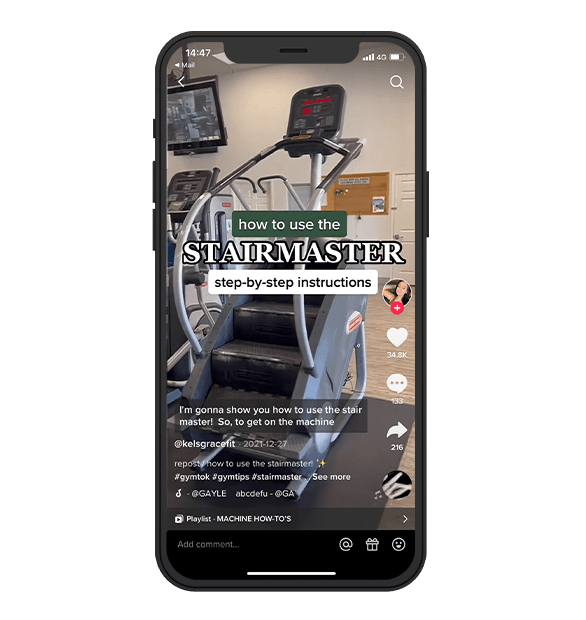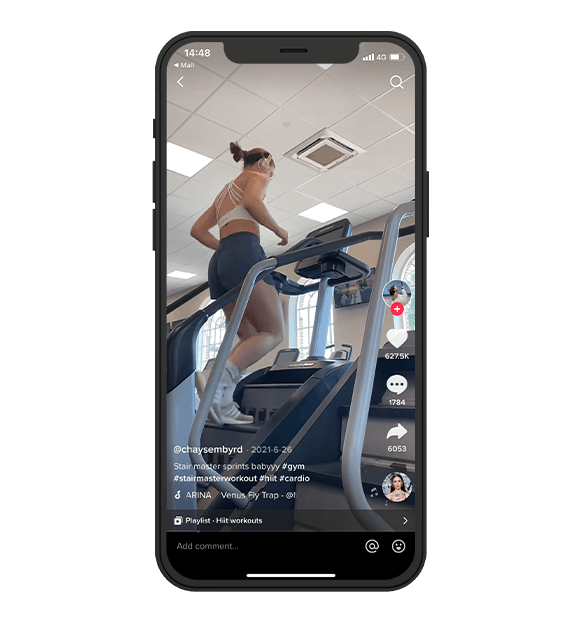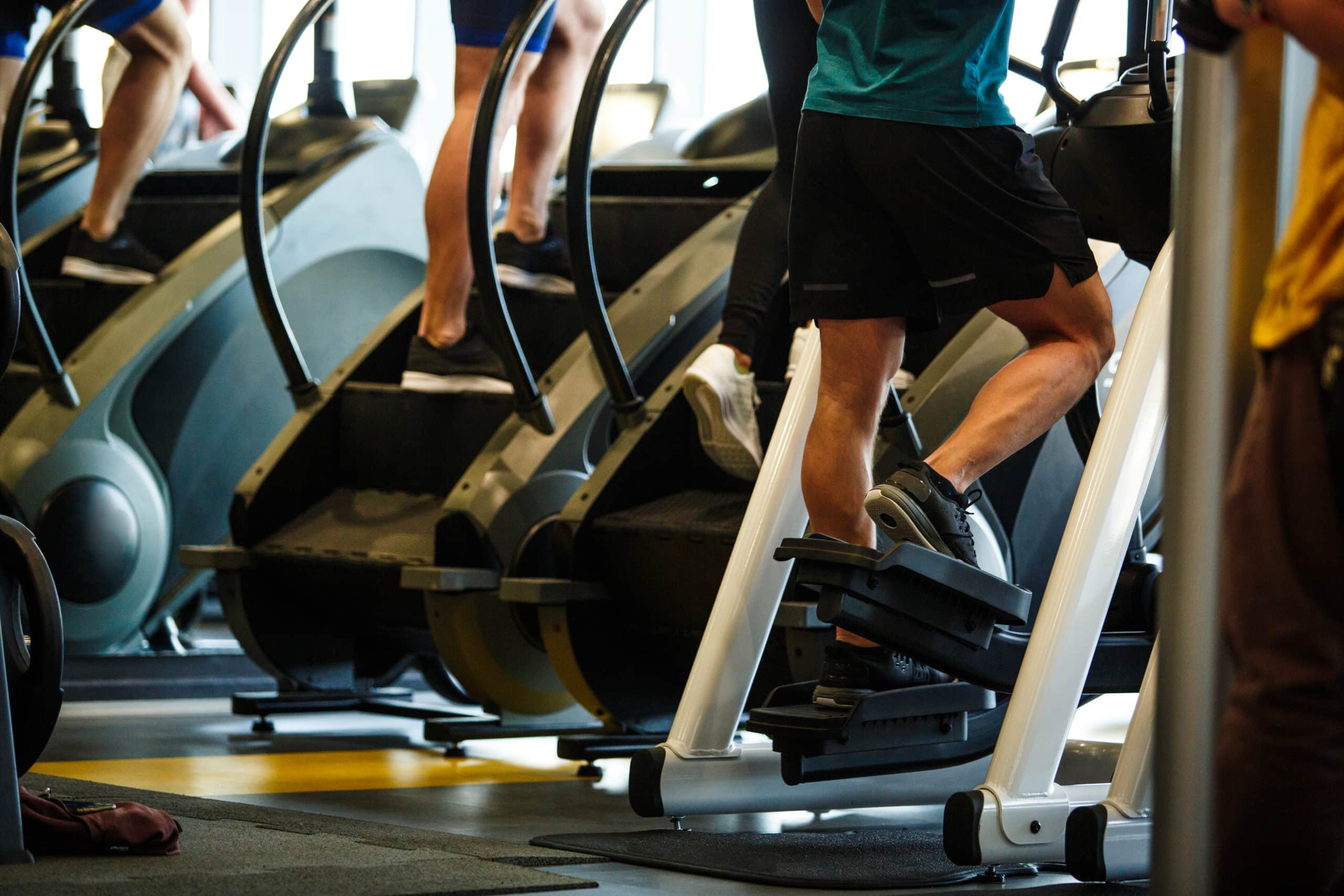Step up to this low-impact leg burner. The new viral #stairmasterworkout TikTok trend has already clocked up 24.7 million views, with gym-goers rushing to the infamous rotating stepping machine for a seemingly never ending cardio-burn.
How The Stairmaster Works
We need aerobic fitness workouts to help strengthen our heart and lungs. To get your heart pumping without placing stress and impact on your knees and joints, head for the Stairmaster. The Stairmaster workout targets the largest muscles in the body (think the quads, hamstrings, glutes and most crucially, the core).
Why You Need To Try The Stairmaster Workout
It’s the low-impact cardio workout that’s now stepping out of the shadow of the treadmill. The Stairmaster workout fires up your functional fitness too, helping to train your posture for everyday situations.
“A lot of us spend a large majority of our time sitting down these days, and then jump into a workout that uses lots of hugely dynamic powerful movements that we would never usually do day-to-day. The beauty of functional fitness is that some exercises and movements can help support our daily lives. Just like squats can build our muscles for standing up effectively from sitting down, or lifting heavy objects – Stairmasters help us to build strength and endurance in the muscles we use to climb stairs and walk uphill.”
Jenny Francis-Townson, fourfive ambassador and personal trainer.
4 Tiktok Tips For The Best Stairmaster Workout
1. Beginners Stairmaster Workout
It’s all about posture. By working to stand up straight whilst you step, you can simultaneously send any strain from your lower back straight down to your glutes with a slight hinge at the hips. Less work on the back = more work for the legs.
“Our posture isn’t just about how we look,” Jenny suggests. “If we don’t support ourselves with a good posture, we risk causing ourselves injury, feeling pain, not performing exercises properly and even risk impacting our digestion and our immunity.”
“Strong and engaged glutes help to minimise back pain, support our knee joints and help us to generate speed and power during exercise – improving our overall fitness performance.”
If you’re brand new to the Stairmaster, focus on nailing your balance before adding any speed. Whilst it may be tempting to cling on for dear life, try to maintain a light grip on the handlebars whilst you get your bearings.

As you progress, you can work towards taking your hands off completely or just using one hand at a time like @shutupcamilla. Using no hands will send your abdominal muscles into overdrive as they work to stabilize and keep you upright. In the meantime, avoid hanging onto the bars as this technique ends up taking the load off your body, meaning your muscles have to work less. Make them work harder for a more efficient workout.
To get rid of any gym nerves, here’s how @kelsgracefit recommends using the Stairmaster safely. Sometimes, getting on the machine itself can be the most daunting part of the workout!

2. Stairmaster Workout: HIIT Sprints.
Enter the ‘afterburn effect’. By utilising the biggest lower body muscles, we fire up our body’s metabolism which continues to burn calories long after you’ve stepped off the machine. To turn up the afterburn, focus on a High Intensity Interval Training (HIIT) style of stairmaster workout. Aim for racking up short periods of intense work followed by small recovery breaks.
Here’s @chikinnugs with her 30 seconds on/30 seconds off speed circuit, where eight minutes felt like she was on the Stairmaster “for a decade.”

“Ten minutes of this is equivalent to 30 minutes of jogging in my books,” Chayse admits.
fourfive’s personal trainer Jenny explains the difference between running and the Stairmaster. “All exercise has some form of impact on our joints BUT low impact movements put a lot less pressure and stress on our joints.”
“Jumps and high impact movements put extra stress on the joints, connective muscles and tendons and can leave regular participants with sore joints or injury. But this doesn’t mean you shouldn’t enjoy an advanced, high cardio, super sweaty workout style if that’s what you love.”
“Low Impact Training can still increase the heart rate and you can still work as hard and fast as you can with all the jumps and high impact movements removed. The beauty is, you get the best of both worlds—a challenging full-body workout that burns fat, and movements that take that extra level of stress away”.
Plus, the Stairmaster workout is ideal for training overall fitness levels. According to a study in the British Journal of Sports Medicine, eight weeks of five-minute sessions on the Stairmaster increased the female participants’ cardio capacity by 17%. These short sessions of stair climbing tapped into anaerobic training when oxygen is in greater demand thanks to shorter periods of intense exercise. Try to remember the results next time you’re short of breath.
3. Stairmaster Workout: Endurance Training
For a cardio burn more like a marathon instead of a sprint, turn down the speed but keep the heat by working at a constant state of Low Intensity Steady State (LISS). By working at a lower intensity for longer periods (around 20 or 30 minutes at a time), the shift focuses from pure calorie-burn to building stamina and muscle endurance. @styleangel shows us how the Stairmaster doesn’t always have to feel like a race to the finish to get results.

4. Stairmaster Workout: Unilateral Moves
Unilateral training is the process of using a single arm or leg to move. We all have a dominant side – you know the feeling when your ‘good’ arm is in a sling- so working unilaterally helps to train both sides of the body equally. By working on one leg at a time, your core switches on to keep you from falling, whilst your body learns to recover from any overcompensation if one side is stronger than the other.
Try this beginner Stairmaster workout from @ohthatscourt7 which combines stair skips with lateral steps to hit every leg muscle – front, back and sides.

Benefits Of Low-Impact Exercise
Aids Weight Loss
“You still work as hard and increase your heart rate, helping to burn calories as your body accesses your fat stores for energy. A lot of low impact movements also work the full body, meaning most of the major muscle groups are worked hard, helping to burn even more calories.”
Improves Joint Mobility
According to Jenny, “low impact movements help to lengthen and stretch your muscles that promote blood flow through your joints, allowing your body to work more efficiently.”
Increases Strength and Endurance
“Low Impact exercises improve both strength and cardio fitness while also working on your muscle density, helping to improve stability and endurance. Plus, low impact training helps to minimise the dangers because it removes exercises that require you to jump.
A lack of these plyometric movements reduces the impact on your muscles and joints and reduces your risk of muscle tearing and strain.”
Why You Should Try Low Impact Workouts
Whether you have sore joints or have a weak pelvic floor, Low Impact training can be a great way to keep exercising if you have ailments as it removes the high impact moves from training and therefore removes the fear around working out.
If you are already suffering with joint discomfort but want to keep your fitness levels up, Low Impact can be your new best friend.
So, next time you hit the stairs at the office, count it as clocking up some low impact exercise and think ‘chest up, back straight!’.

